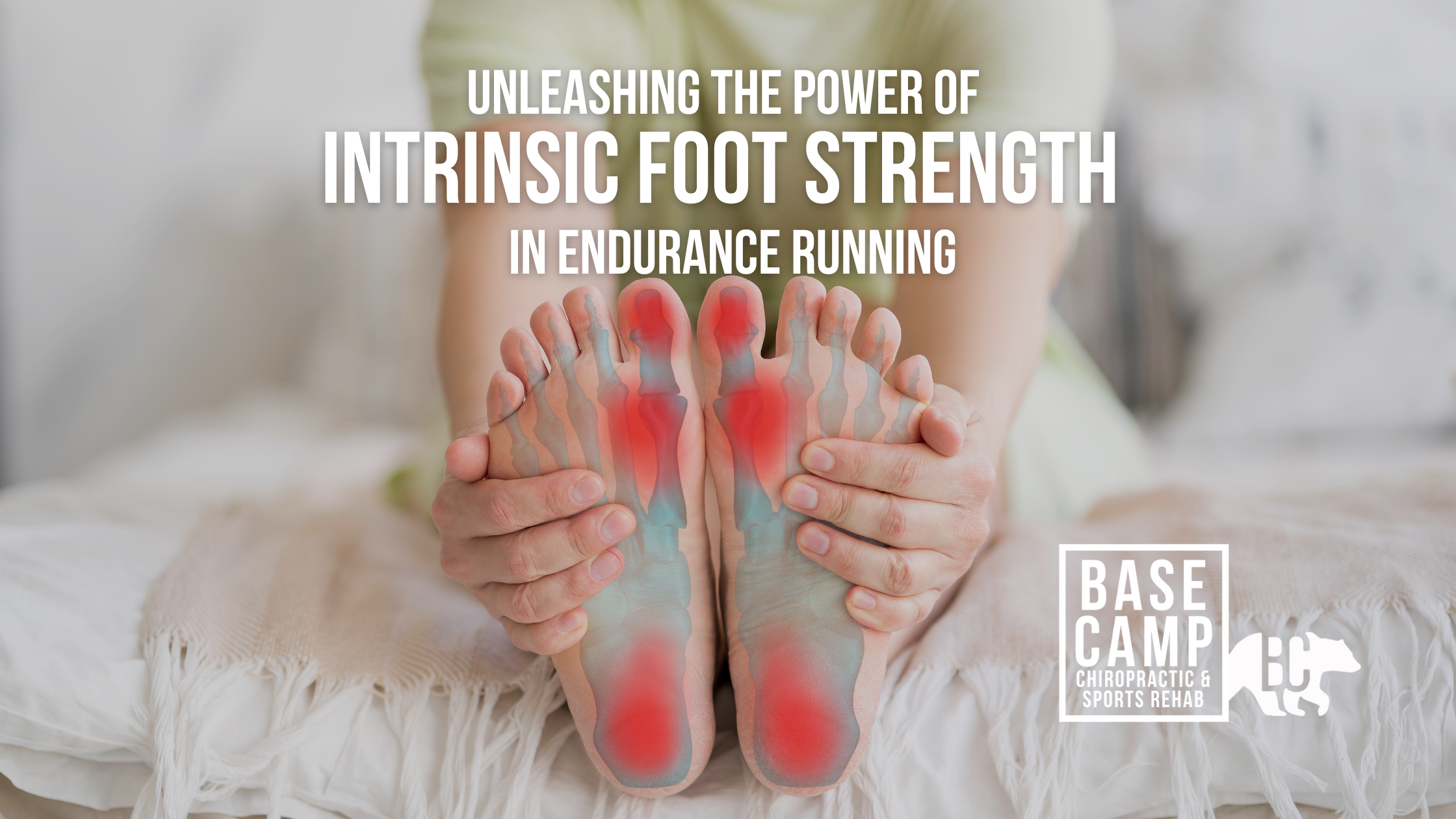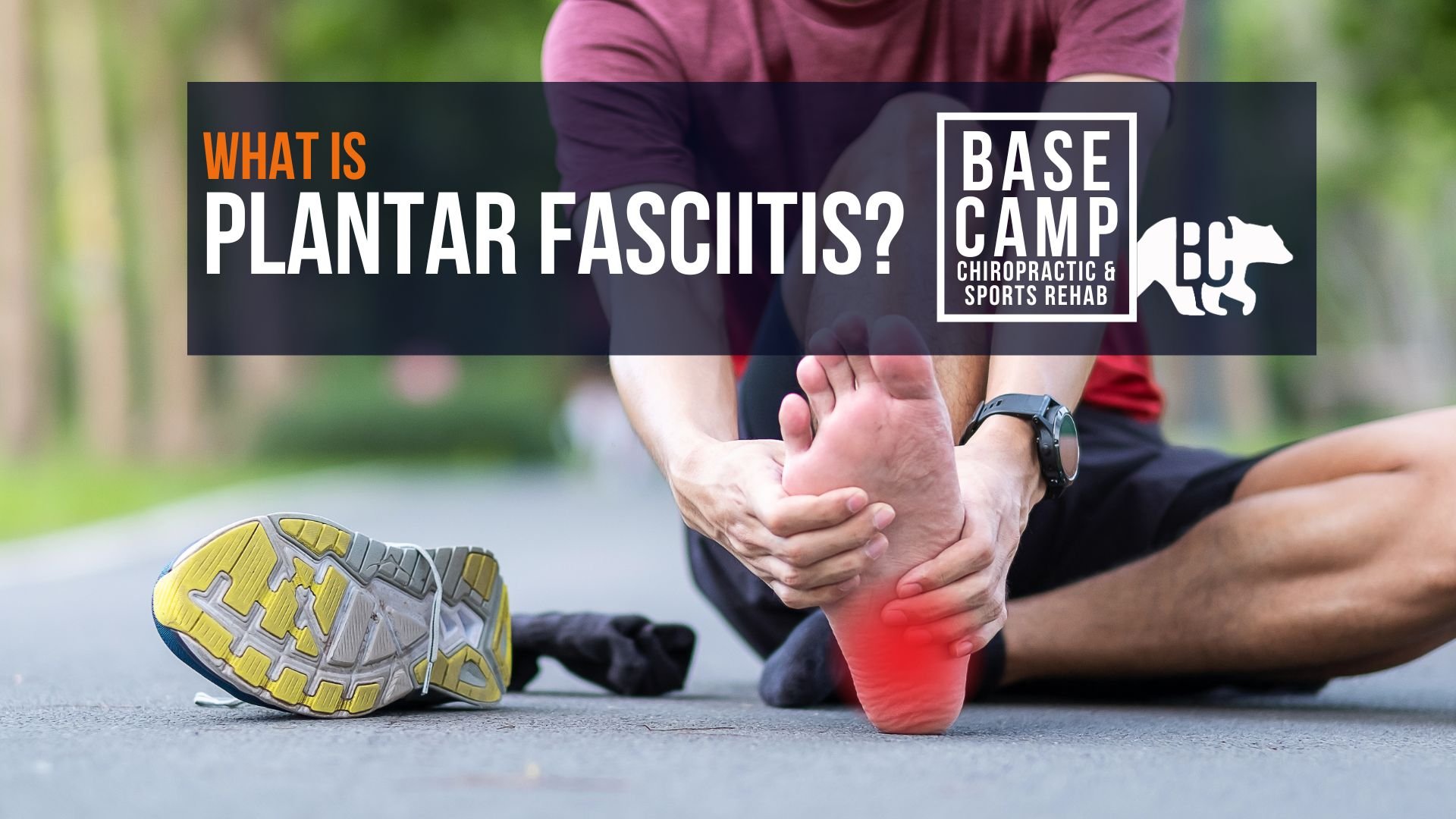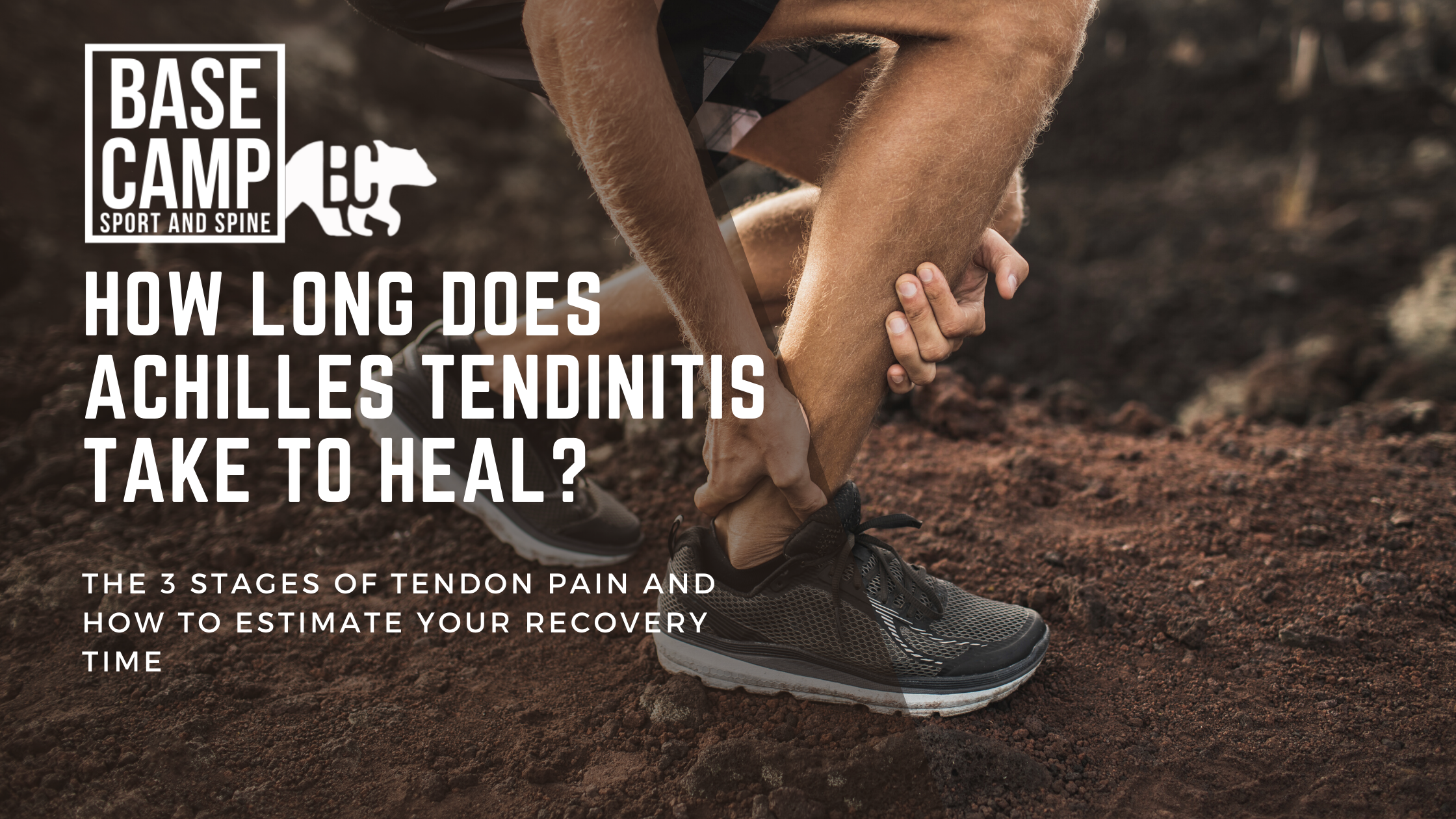
Blog
want to take a crack at your problems from home? Check out our blog posts and find the topics specific to you
Topics:
Unleashing the Power of Intrinsic Foot Strength in Endurance Running
In the world of running, where every stride adds up and the body keeps score, the significance of intrinsic foot strength often goes unnoticed until it can’t be ignored. While many runners focus extensively on building leg strength, improving cardiovascular endurance, and perfecting their running form, the role of the feet tends to be overlooked. However, understanding and harnessing the power of intrinsic foot strength can be a game-changer for endurance athletes, enabling them to run longer, faster, and with reduced risk of injury.
Introduction:
In the world of running, where every stride adds up and the body keeps score, the significance of intrinsic foot strength often goes unnoticed until it can’t be ignored. While many runners focus extensively on building leg strength, improving cardiovascular endurance, and perfecting their running form, the role of the feet tends to be overlooked. However, understanding and harnessing the power of intrinsic foot strength can be a game-changer for endurance athletes, enabling them to run longer, faster, and with reduced risk of injury.
What is Intrinsic Foot Strength?
Intrinsic foot strength refers to the strength and stability of the muscles within the foot itself. These muscles play a crucial role in maintaining proper foot mechanics, providing support, absorbing shock, and facilitating efficient propulsion during running.
Why is it Important for Endurance Runners?
Endurance running places significant demands on the feet, as they repeatedly absorb the impact of each stride over long distances. Weakness or instability in the intrinsic foot muscles can lead to various pain patterns, including plantar fasciitis, shin splints, and bone stress injuries. By developing strong and resilient feet, endurance runners can enhance their performance while reducing the risk of common overuse injuries.
Benefits of Strong Intrinsic Foot Muscles:
1. Enhanced Stability: Strong intrinsic foot muscles contribute to better foot stability, allowing runners to maintain proper alignment and balance, especially on uneven terrain.
2. Improved Propulsion: A strong arch provides a solid platform for pushing off the ground with greater force, resulting in more powerful strides and increased speed.
3. Injury Prevention: By distributing forces more evenly throughout the foot, strong intrinsic muscles help reduce the risk of overuse injuries caused by excessive stress on specific areas.
4. Efficient Energy Transfer: Proper foot mechanics supported by strong intrinsic muscles optimize energy transfer from the ground to forward motion, conserving energy and delaying fatigue during long runs.
How to Develop Intrinsic Foot Strength:
1. Barefoot Exercises: Performing exercises barefoot, such as toe scrunches, arch lifts, and towel curls, can target and strengthen the intrinsic foot muscles.
2. Minimalist Footwear: Transitioning to minimalist or barefoot-style shoes encourages natural foot movement and strengthens the muscles by providing less cushioning and support.
3. Foot Strengthening Tools: Using tools like resistance bands, balance boards, or specialized foot strengthening devices can further challenge the muscles and improve their strength and endurance.
4. Gradual Progression: It's essential to progress gradually when training the intrinsic foot muscles to avoid overuse injuries. Start with low-intensity exercises and gradually increase the duration and intensity over time.
Incorporating Intrinsic Foot Training into Your Routine:
Integrating exercises to strengthen intrinsic foot muscles into your regular training regimen can significantly benefit endurance runners. Whether you're a seasoned athlete or just starting your running journey, prioritizing foot strength can lead to better performance, fewer injuries, and a more enjoyable running season.
Conclusion:
Building strong intrinsic foot muscles is not only essential for injury prevention but also for maximizing performance potential. By paying attention to the foundation of their stride, runners can unlock new levels of strength, endurance, and resilience on the road or trail. So, lace up your shoes, strengthen those feet, and embrace the transformative power of intrinsic foot strength in your endurance running journey.
Get Back Out There!
-Dr. Sam
The 3 most common types of knee pain in runners
Learn the most common types of knee pain in runners and why most runners never get better.
It's Dr Mark here from Base Camp.
Knee pain sucks. Straight up. Almost every runner will experience an injury at some point. The knee is the most common running-related injury runners experience.
The good news is, for most runners, it doesn't have to stop you.
Most often, running-related knee pain from 1 of 3 different causes:
The Patellofemoral joint pain (the knee cap, the muscles, and the tendons associated with it)
The Iliotibial Band pain (aka the IT Band)
Osteoarthritis (inflammation of the knee joint)
All three of these injuries have their causes and specific solutions.
Despite that, they all come down to the same thing: doing too much, too soon.
Your body wasn't prepared for the demands you placed on it.
It happens.
BUT... if you don't want to end up in REHAB PURGATORY then take them seriously.
For runners, there are three types of knee pain you need to understand.
The first is Patellofemoral Pain (PFP) in the FRONT of the knee, and the second is Iliotibial Band (ITB) Pain on the OUTSIDE of the knee.
None of them are fun.
But they don’t have to be permanent or keep you from hitting your running goals.
In fact, chances are good if you are a runner that you will experience either PFP of ITB pain at some point in your running career.
The WRONG thing to do is ignore it, keep running at the same intensity and volume, and just hope it goes away.
Let’s talk a little bit about both types of pain and your first line of defence for both of them…
1. PATELLOFEMORAL PAIN (PFP)
Patellofemoral Pain (PFP) is pain that is located on the anterior aspect of the knee (the front).
The word sounds scary, but really it just means pain related to the patella (your knee cap) and your femur (your leg bone). Often, the tendon is involved and can be one of the primary pain generators for PFP. It tends to be MUCH more common in women (2-3 times as common in fact) and can take a long time to resolve (for some stubborn cases it can last more than a year).
Pain tends to come on slowly, and may or may not be present during every run.
In my experience, runs with a lot of downhill mileage are notorious for flaring up PFP. This is likely mainly due to the way the quad muscles need to contract to stabilize the knee while travelling downhill, even at moderate grades.
One of the most common symptoms of PFP is pain with ascending and descending stairs.
2. Iliotibial Band Pain
Iliotibial Band Pain is pain that is located on the lateral aspect of the knee, where the Iliotibial Band (ITB) connects to the lower leg bone (the tibia, which is your shin bone).
Like PFP, ITB Pain tends to come on slowly, but once it comes it rarely goes away without a fight. The pain is often worse with early knee bending (when the knee is bent to about 30 degrees) and wreaks havoc on activities like cycling and downhill running.
The function of the ITB is to preserve force while we are walking or running, and stabilize the lateral knee. Pain comes on when the bursa (and fluid-filled sack) that is located deep to the ITB insertion becomes irritated.
ITB pain is often intense and debilitating.
3. Osteoarthritis (OA)
The third type of knee pain is osteoarthritis-related knee pain.
A lot of people think that running is bad for your knees and causes OA. The reality is that osteoarthritis is LESS common in recreational runners, which means that it is actually PROTECTIVE from arthritis!
The key is to get the dosage right.
If you have already had a knee injury, there is a higher chance you will develop OA and OA-related knee pain, but it is not guaranteed.
When there is degeneration, joint changes, or arthritis in the knee, your knee is more sensitive to triggering pain. But… the dosage makes the poison. Over time, you can build up your running volume and run without pain, even if you have arthritis.
WHAT TO DO ABOUT RUNNING KNEE PAIN?
THE TYPICAL CYCLE OF RUNNING INJURIES…
Unfortunately… most running injuries tend to follow this pattern:
Initial Injury from too much running volume
> Runner takes a couple of days off because of the pain
>> The pain gets better because the pain trigger (running) is absent, but because they took time off, their tissue fitness also decreased
>>> Runner returns to running at their usual pace and volume without building the tissue tolerance back up or following a progressive plan
>>>>> The runner gets injured AGAIN and starts the cycle all over.
Ready to BREAK THE CYCLE?
the better strategy:
Regardless of the type of knee pain, the approach remains pretty much the same, with some subtle tweaks.
The first step is to try and rule out something worse PFP or ITB Pain which are both ‘non-complex’ biomechanical conditions. We want to make sure it isn’t something more severe like a bone-stress injury (stress fracture), connective tissue injury like a meniscus tear or ligament damage, or infection/disease-related. We can’t always rule these things out, but we try and be as confident as possible that the pain is in fact something we can deal with conservatively (without drugs/injections or surgery).
Don’t misinterpret the above information though. Just because something isn’t ‘medically’ serious, doesn’t mean the pain isn’t severe or debilitating.
IF the pain does in fact fall into the category of either PFP or ITB Pain, we take a 3-step approach to managing, fixing, and preventing the condition from coming back.
Step 1: CALM STUFF DOWN
Step 2: BUILD BACK UP
Step 3: BRIDGE THE GAP
Step 1: CalM Stuff Down
The first thing we need to do with either knee pain condition is to calm down the pain so you can get back to running without making things worse.
Our first line of defence is some DELOAD work. This means taking a few days or weeks off. No runner likes to hear this. But some sort of deload is essential for calming the pain down. For some runners, that does not mean COMPLETELY stopping running. We try really hard to keep runners running, because we know one thing is true: RUNNERS LIKE TO RUN.
Step 2: Build Back Up
Once the pain has calmed down a bit, then we move into our Build phase. This focuses on building your strength, endurance, and tissue tolerance back up to handle the demands of running. This usually looks like some strength and cardio training BELOW symptom threshold.
Step 3: Bridge the Gap
Once we have built the tissue tolerance back up, we need to bridge the gap from rehab back to performance. Just because the tissue is strong, does not mean it is necessarily ready for the demands of the running you were doing before injury.
This process is collaborative and involves some trial and error. Too much too soon? We take two steps backwards.
While it is tempting to jump right back into your regular running routine because you are feeling so much better, it is a much better idea to gradually build your running volume back up.
Ok… but what does that actually LOOK like?
Fair question, that I wish I had a straightforward answer to. Unfortunately, everyone is different. There is no single exercise, stretch, or rehab plan that works for everyone.
If your knee pain is keeping you from running, or doing anything else you love, I HIGHLY recommend you seek out a qualified provider.
That said, if you want to take a shot at fixing your pain yourself from home, here are some of the exercises I often use with my patients.
PFP EXERCISES:
Tempo Squats (3-seconds down, 1-second hold, 1-second up, 0-second rest at the top)
Rear Foot Elevated Split Squats
ITB Pain Exercises
Stationary Cycling (with your knee flexed to about 35 degrees at the bottom of the stroke. Move your seat forward and down to accomplish this).
Uphill Treadmill Walking (8-10 degrees incline)
Rear Foot Elevated Split Squats
Want 1-on-1, personalised rehab?
Author: Dr Mark Murdoch, Chiropractor and Co-Founder at Base Camp Chiropractic and Sports Rehab in Vernon, BC.
Mark Murdoch is a Doctor of Chiropractic with a Master’s Degree in Sports Medicine.
Contact: drmurdoch@basecampclinic.com
Instagram: Base.Camp.Doc
Morton’s Neuroma
Morton's neuroma is a common condition that affects the nerves in the foot, typically between the third and fourth toes. It occurs when the tissue surrounding a nerve thickens, leading to compression and irritation of the nerve.
This condition often causes pain, tingling, or numbness in the affected area of the foot. Symptoms may worsen with activities that put pressure on the foot, such as walking or wearing tight shoes. Some people describe the sensation as feeling like there's a pebble or marble inside their shoe.
The exact cause of Morton's neuroma isn't always clear, but factors such as wearing high heels or tight shoes, participating in high-impact activities, or having certain foot deformities can increase the risk of developing it.
Diagnosis of Morton's neuroma typically involves a physical examination and may include imaging tests such as X-rays or MRI scans to rule out other possible causes of foot pain.
Treatment options for Morton's neuroma may include wearing supportive footwear with a wider toe box, using orthotic inserts or pads to relieve pressure on the affected area, corticosteroid injections to reduce inflammation and pain, or in severe cases, surgery to remove the affected nerve tissue.
It's essential to seek medical advice if you experience persistent foot pain or discomfort, as early diagnosis and treatment can help alleviate symptoms and prevent complications.
plantar fasciitis
Is this you?
This weekend you had a long run. The spring is here! With the sunshine back, you are motivated and inspired to get outside and cruise some longer distances. It feels great to run in the sun!
But…
This morning you woke up, like any other morning, stepped out of bed looking forward to your morning coffee but BAM!
Did you step on something??? Holy smokes! It feels like you are walking on GLASS! The first five steps are the worst. Then it backs off a bit.
Uh oh…
You’ve heard of this before. Your running mate had this last year and is just now getting back to running…
Is this the dreaded PLANTAR FASCIITIS?
Let’s talk about it.
Most runners have heard about Plantar Fasciitis. It is a dreaded injury that can sideline your running season.
Truly, a pain in the foot…
Specifically the heel.
WHAT IS PLANTAR FASCIITIS?
To understand plantar fasciitis, let’s talk about what FASCIA is and then specifically the PLANTAR FASCIA
FASCIA is connective tissue. It runs throughout the body and encases our muscles and joints. It is super important for the structure of our muscles and joints. One of its primary functions is transferring force along the kinetic chain. In this case, we are talking about the posterior chain, which runs from the bottom of your foot all the way up to the back of your hip and beyond.
Think of the fascia in your feet as a strong, stretchy band that runs along the bottom, kind of like a rubber band. When you run, this fascia helps support your arches and absorbs the shock from each step you take. But sometimes, especially if you've increased your running a lot, this fascia can get irritated and sensitized.
It's like if you keep pulling on that rubber band too much, it might start to get sore and swollen. When your plantar fascia gets inflamed, it can feel like a sharp pain in your heel or along the bottom of your foot, especially when you first step out of bed in the morning.
The PLANTAR FASCIA is an especially thick section of fascia that runs from your heel to the ball of your foot. It is SUPER STRONG and helps absorb and transfer force every step while running and walking. When we step and load the foot, the plantar fascia stretches while the arch of the foot lengthens. Along with the muscle of the foot, the plantar fascia keeps the arch from collapsing, while making us more efficient walkers/runners.
In PLANTAR FASCIITIS, the origin point of the plantar fascia becomes irritated and VERY painful. A common belief is that the fascia becomes inflamed, but this actually is not true! It’s more accurate to say that the plantar fascia and the nerves around it are irritated, but not necessarily inflamed.
WHAT CAUSES PLANTAR FASCIITIS (plantar heel pain)?
Like any running injury, plantar fasciitis can be caused by running too much too soon. When the amount of activity you do exceeds the amount of activity you can recover from, it can cause plantar fasciitis (or other running injuries!).
But… plantar foot pain is common in people who don’t run. This means that running alone isn’t the cause of plantar fasciitis. The plantar fascia is loaded in running, walking, and even standing. We see plantar fascia pain in people who stand or walk a lot for work, sedentary people, and people with higher BMI (body mass index).
It is possible to have plantar fascia pain without an increase in running volume, but in active people we usually see a pattern of increased activity leading to symptoms!
A big issue with plantar foot pain is that once we ring that bell, it can be really hard to settle. It is important to get on top of it early to keep it from becoming a larger, more debilitating issue!
HOW DO WE DIAGNOSE PLANTAR FASCIITIS?
If you work with a Sports Chiropractor or Physiotherapist in Vernon, we will do a thorough history and physical exam. The combination of these will tell us if this is plantar fasciitis or something else.
In the physical exam, we will test the foot and plantar fascia to see if it fits classic plantar fasciitis. If not? It may be coming from somewhere else entirely (more on this later!)
HOW DO WE TREAT PLANTAR FASCIITIS?
Treating running-related injuries is simple, but not always easy.
We need to take three steps to get you back running without plantar fasciitis coming right back.
RESET: managing pain, while removing or modifying the things that are causing the symptoms in the first place. This typically involves a period of RELATIVE rest (decreases running, but not always eliminated).
RESTORE: improve mobility, strength, and endurance to prepare you for returning to running at the volume and intensity that you want to be at. This means specific and progressive exercises to strengthen your feet!
RELOAD: get back to running at the volume and intensity you were before the injury!
Treatment options for PLANTAR FASCIITIS
Forget about icing and popping anti-inflammatories for long-term relief. We're not dealing with a classic inflammation scenario here. While rolling your foot on a frozen water bottle or lacrosse ball might offer some relief, it's not the main game plan for treating plantar fasciitis. We're not out to break up scar tissue or change your foot's structure either. If rolling feels good and fits into your rehab strategy, go for it, but it's not a must-do.
Manual Therapy
At Base Camp, we often use muscle work, scraping, taping, and joint adjusting to decrease pain. You can also use some self-myofascial manipulation using a ball to roll out the bottom of your foot or calf. It’s important here to know that this IS NOT a NO PAIN NO GAIN scenario. Less is more when it comes to rolling out your foot and calf.
Changing footwear and/or heel lift
Footwear can temporarily change your symptoms. Using a shoe with more cushion, and a heel lift, can decrease the tension on the plantar fascia.
Stretching
Stretching out the bottom of the foot and the plantar fascia as soon as you wake up, before and after activity, and as a pain control method can be helpful. Try this tried and true plantar fascia stretch
Foot Strengthening
Strengthening a few muscles in the foot, ankle and calf can support the plantar fascia. Here are a few I give a lot (videos at the bottom of this section):
Toe Yoga
Foot Doming
Calf Raises
Then what?
Runners Injury Purgatory.
Where most people fall short is when trying to return to running. They return too soon, without a progressive plan. After a plantar fascia injury, you need to take your return to running slowly and progressively.
Just because the pain is gone, does not mean you are ready to run.
Returning to running too early or at an intensity you are not ready for can land you in the dreaded RUNNERS INJURY PURGATORY!
This is when you repeatedly get injured from running every time you try and start again.
In order to avoid that, a well-structured walk-run program is key!
This is equally important if you have an active goal that is not running.
Using progressive exercise is the best way to get you back to doing your activity without plantar fascia pain coming back.
But… what if it isn’t even plantar fasciitis in the first place?
Plantar fasciitis is WAY over diagnosed.
Every season I see patients come in who have been suffering from plantar fasciitis for months, throwing every treatment they can think of at the foot and getting nowhere, just to find out… it was never plantar fasciitis to begin with.
If your pain is NOT:
WORST in the MORNING with the first few steps
Improving after sitting, only to come right back when you stand up
…and if your pain IS:
WORSE at the end of the day
WORSE with sitting
INCREASING with walking
INCREASING when your lower back pain gets worse
DULL/ACHY/TINGLING/BURNING and never SHARP…
Then your pain might not be related to the plantar fascia in the first place! This is why it is important to get assessed by a clinician who works with foot and ankle injuries, so that you can have confidence you are on the right path!
If your clinician or doctor tells you to:
Get orthotics
Ice your foot
Take ani-inflammatories
or change your footwear…
..without assessing your ankle, knee, hip and lower back… then there is a chance you are being treated for plantar fasciitis, when that is not even the issue!
Dr Mark Murdoch is a runner, chiropractor, and rehab specialist in Vernon, BC.
Every week he works with runners, mountain bikers, and adventure athletes who want to get back to their sport better than ever.
Request a free consult with him here: CONTACT
ankle sprains: the most under-rehabbed injury
Ankle sprains are like uninvited guests at a party – they show up unexpectedly and can be quite a nuisance. Whether you're an athlete or just someone who enjoys an occasional stroll, chances are you've experienced the discomfort of an ankle sprain at some point in your life. But what exactly is an ankle sprain, and why do they often linger longer than expected?
Anatomy of an Ankle Sprain
When we talk about ankle sprains, we're usually referring to injuries involving the ligaments on the outer side of the ankle. These ligaments, such as the anterior talofibular ligament (ATFL) and the fibulocalcaneal ligament, are crucial for stabilizing the ankle joint. Ankle sprains typically occur when the foot rolls inward, stretching or tearing these ligaments in the process.
Ankle sprains are graded based on severity, ranging from grade one (mild stretching) to grade three (complete ligament tear). Even in milder cases, the loss of proprioception – the body's ability to sense joint position – can significantly impact recovery and increase the risk of future sprains.
Why Your Ankle Sprain Lingers
If you've found yourself still bothered by an ankle sprain long after the initial injury, you're not alone. Here are three common reasons why ankle sprains can be persistent:
1. Inadequate Rehabilitation
One of the biggest mistakes people make is discontinuing rehabilitation once the pain subsides. While pain relief is important, true recovery requires comprehensive rehabilitation that goes beyond symptom management. Building strength, improving balance, and restoring proprioception are essential for long-term ankle health.
2. Ineffective Rehab Strategies
Traditional rehabilitation methods often focus on unstable surfaces like wobble boards and foam pads. While these tools have their place, they may not adequately prepare the ankle for real-world challenges. Functional exercises that mimic daily activities or sports-specific movements are more beneficial for restoring stability and preventing re-injury.
3. Lack of Activity-Specific Training
If your goal is to return to running, hiking, or any other physical activity, it's crucial to incorporate that activity into your rehabilitation plan. Merely strengthening the ankle in isolation may not translate to improved performance or reduced injury risk in your chosen activity.
Choosing the Right Footwear
Another aspect often overlooked in ankle sprain recovery is footwear selection. Contrary to popular belief, bulky, cushioned shoes may not be the best choice post-injury. Minimalist footwear with a low stack height (the distance between your foot and the ground) can promote better ankle stability by minimizing the lever arm during foot inversion.
While minimalist shoes are ideal for everyday use, exceptions exist for activities requiring additional support, such as backpacking or heavy lifting. In such cases, footwear with increased ankle support may be warranted to mitigate the risk of re-injury.
The Road to Recovery
Rehabilitating an ankle sprain isn't just about reducing pain; it's about restoring function and preventing future injuries. A comprehensive approach that addresses strength, balance, proprioception, and activity-specific training is key to achieving optimal outcomes.
If you've recently sprained your ankle or are still grappling with lingering symptoms, don't hesitate to seek professional guidance. By investing time and effort into your rehabilitation, you can overcome the limitations of your ankle sprain and get back to doing what you love – pain-free and with confidence.
Rehab Exercises:
Week 1: GOAL is to improve range of motion, reduce swelling, and reduce pain. VIDEO
Week 1-2: Restore Range of Motion and load in pain-free range. VIDEO
Week 2+: Increased ankle loading and ligament loading. VIDEO
Week 4+: Improve strength, endurance, and tolerance to inversion stress
Week 6-8+: Increase power, speed, resilience, and stability, preparing for sport-specific demands
Do NOT STOP your rehab plan when your pain is gone. KEEP GOING until you have returned to FULL FUNCTION!
Your plan should be at least 8 weeks. Yes, even for a Grade 1 ankle sprain.
Healing takes time, especially when you want to get back to meaningful activities.
Need help? Book a free consult with us!
Dr Mark Murdoch is a runner, chiropractor, and rehab specialist in Vernon, BC.
Every week he works with runners, mountain bikers, and adventure athletes who want to get back to their sport better than ever.
Request a free consult with him here: CONTACT

















Learn the most common types of knee pain in runners and why most runners never get better.